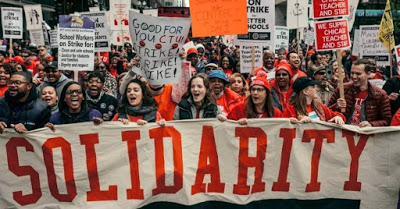Chicago teachers fight ‘for the common good’
 |
| Scott Scheffer – November 3, 2019 |
After 11 days on strike, delegates of Chicago Teachers Union have suspended the Chicago teachers’ walkout and members are headed back to their classrooms.
A tentative agreement has been reached with Chicago Public Schools that appears to have secured a good deal for the workers on “bread and butter” issues, and victories on items the union had pressed for that would improve conditions for their students and for the community. A vote by the full membership is imminent.
Seventy-five-hundred education support workers in SEIU Local 73 struck along with CTU and accepted an agreement last Sunday. The wage increases range between 17 percent and 40 percent over five years, nearly doubled sick days for some staff and restrictions on the use of private contractors. In a show of solidarity, Local 73 continued to walk the picket lines along with their 25,000 teacher co-workers.
There were many other acts of solidarity with CTU during the strike. A fantastic video/music recognition of the progressive demands that the strike leaders made was posted on Facebook by musical legend Rebel Diaz.
Teamsters Local 705 Secretary-Treasurer Juan Campos announced that no Teamsters would cross the picket line. On Oct. 29, the Latino Caucus of the Chicago City Council publicly urged Mayor Lori Lightfoot to settle. Their support was important in majority Black and Brown Chicago, 47 percent of Chicago’s student population are Latinx.
At that point, CTU leadership said they were within $38 million of a settlement. The administration said the gap was actually $100 million. The difference is due to sleight of hand by the administration. When the new city budget was written in April, teacher pensions — some $60 million — were shifted to the separate budget of Chicago Public Schools. All other public workers’ pensions remained in the city’s budget. The shift was meant for leverage during the negotiations with CTU that the administration knew would happen later in 2019.
As the city administration cried poverty and deceived the public about the availability of the $38 million needed to settle the strike, CTU members rallied at Lincoln Yards – the site of a huge high-end apartment complex being built by developer Sterling Bay. The real estate corporation had been gifted more than $1 billion in taxpayers’ money by the city to incentivize the project.
The city’s intransigence finally crumbled. During what was described as a raucous meeting on Oct. 30, about 700 delegates in the CTU decided in a very close vote to bring the school district’s latest offer to the full membership. There was a great deal of pressure, the negotiations had been tough, and the non-elected Chicago school board was on the verge of cutting off health insurance.
The settlement seems a big improvement over the previous strike in 2012. It guarantees all members a 16 percent raise over the five-year life of the contract, while the CTU had initially asked for a 15 percent increase over 3 years. The city raised its offer for class size support to $35 million. Every school will have a nurse and a social worker by 2023. And 120 new “equity positions” will be added for highest need schools such as counselors, restorative justice coordinators, librarians and additional staffing in bilingual and special education.
School strikes in 2018
In 2018, teachers and other education workers in five different states carried out a series of strikes that showed people across the country the real conditions for teachers. Suddenly people could see the reality of underpaid teachers that used their own money for school supplies, who had to teach oversized classes with not enough books, in crumbling buildings, with no medical staff, no librarians, and no counselors.
Through the strikes the lies that had been propagated by anti-union forces for decades were exposed. It became clear that teachers are as concerned about their students as they are about their own livelihoods. Each strike included demands that promoted the well-being of their students and their communities. For example, in the leadup to the third teachers strike of 2018 in Arizona, when teachers were offered a 20 percent pay raise, they turned it down because it was at the expense of social service programs in the state budget. This was an example of a revived awareness on the part of union leaders of how important the natural alliance between community and unions is.
This trend mushroomed when the educators’ strike wave hit the diverse cities of Los Angeles in January 2019 and then Chicago in November – the second and third largest school districts in the country respectively. In both struggles union leadership raised and won at least partial victories on the issue of sanctuary for the thousands of undocumented students. They attacked the notion of public schools being patrolled by armed police who frequently arrest children. They demanded less of the testing that has been weaponized against students of color.
At the beginning of the Chicago strike they even demanded from the city more money for low income housing. In an article on educationdive.com, United Teachers Los Angeles President Alex Caputo-Pearl referred to the approach in both strikes as “bargaining for the common good.”
“The current Chicago strike,” Caputo-Pearl says, “is a powerful continuation of this movement, transforming education and the labor movement, fighting for common sense demands like more nurses, counselors and social workers, fighting for those against Republicans and Democrats.”


